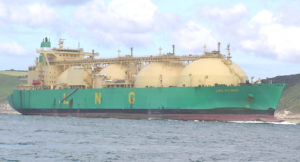
Ireland has been through quite some rough economic times in the aftermath of the financial crunch. But the Irish are natural born fighters and will never easily give in. They also have deep and strong bond to the lands and the waters that host and feed them.
No wonder that – despite the economic struggles they were facing and oil and gas industry promises of jobs and prosperity – the Irish didn’t buy in, but rather fought back.
Instead of believing the shale hype, Ireland opted for the only true path that is able to combine environmental protection, climate action and a boost for the econonmy: in the Summer of 2017, the Green Island banned fracking.
Previously, in January 2017, the Irish Dàil had voted in favour of divesting coal, oil and gas holdings from the €8 billion Ireland Strategic Investment Fund.
But now, at the most decisive moment for Ireland’s transition into a post-fossil fuel future, an absurd debate about the realisation of two unneeded LNG import terminals at Shannon & Cork returns.
Planned LNG Projects in Ireland
The Shannon LNG Terminal is proposed to have a final maximum regasification capacity of at least 10 billion cubic meters (bcm) per year. This is more than twice Ireland’s gas consumption of approximately 4.55 bcm of gas in 2015, while gas demand dropped by nearly 20% between 2010 and 2015. Despite its questionable need, the Shannon LNG terminal has been listed once again as a Project of Common Interest by the EU Commission.
The Cork LNG Terminal is proposed to have an annual import capacity of up to roughly 3.9 bcm of gas.
Both terminals aim at importing fracked hydrocarbons from the United States and could be used for passthrough to the EU – instead of simply fulfilling domestic energy demands.
In 2008, in spite of a negative assessment of the implications for the Shannon LNG site and in the absence of alternative solutions, this project consistently used the excuse of ‘overriding public interest’.
The 10 year planning permission given to Hess Corporation in 2008 for the Shannon LNG terminal will expire in March 2018. The new owner of Shannon LNG is a non-trading shelf company named Sambolo Resources Limited, which applied for an extension of the expiring planning permission in September 2017. We have learned that a decision might be made – without a proper public consultation – before February 2018.
Many important considerations that would have been pivotal in 2008 have changed substantially in 2018.
These include in particular the importation of fracked hydrocarbons from the US that will be absolutely contrary to Ireland’s climate targets – targets that are already hard to meet.
Food & Water Europe, Food & Water Watch and the Irish groups/organisations NotHereNotAnywhere, Friends of the Earth Ireland, Friends of the Irish Environment, Love Leitrim, North West Network Against Fracking, Fracking Free Ireland, No Fracking Ireland, and Safety Before LNG sent an open letter to the Irish authority in charge, An Bord Pleanála, calling for a proper public consultation on the requested extension for the planning permission for the proposed LNG terminal at Shannon.
Back in October 2017, we filed an official statement submitted to the „Public Consultation on the Draft Climate Change Adaptation Plan for the Irish Electricity and Gas Networks Sector“ calling upon the Irish authorities to reject the construction of both LNG terminals at Shannon and Cork.
In May 2017, Ireland joined the Clean Energy for EU Islands’ initiative. According to its goals, the initiative aims to accelerate “the clean energy transition on Europe’s more than 2700 islands” and it “will help islands reduce their dependency on energy imports by making better use of their own renewable energy sources and embracing more modern and innovative energy systems.” The initiative’s goal is also to “help reduce energy costs and at the same time improve air quality and lower greenhouse gas emissions”.
Energy efficiency measures and renewables have a big potential to attract investment and the transition will be good for Ireland by improving people’s health and environment and boosting the economy. The real community benefits lie, therefore, with local energy produced by renewables and increased energy efficiency, not approval and construction of new fossil fuel infrastructure projects like the proposed LNG facilities. New gas development will only lead to a further fossil fuel lock-in which needs to be avoided at all costs.
We at Food & Water Europe and Food & Water Watch truly believe that Ireland could become Europe’s most ambitious 100% renewable energy project. With the US pulling out of the Paris Agreement, Ireland’s continuing clean energy leadership would also show to the world that the EU is sincere in its commitment to fight climate change.


